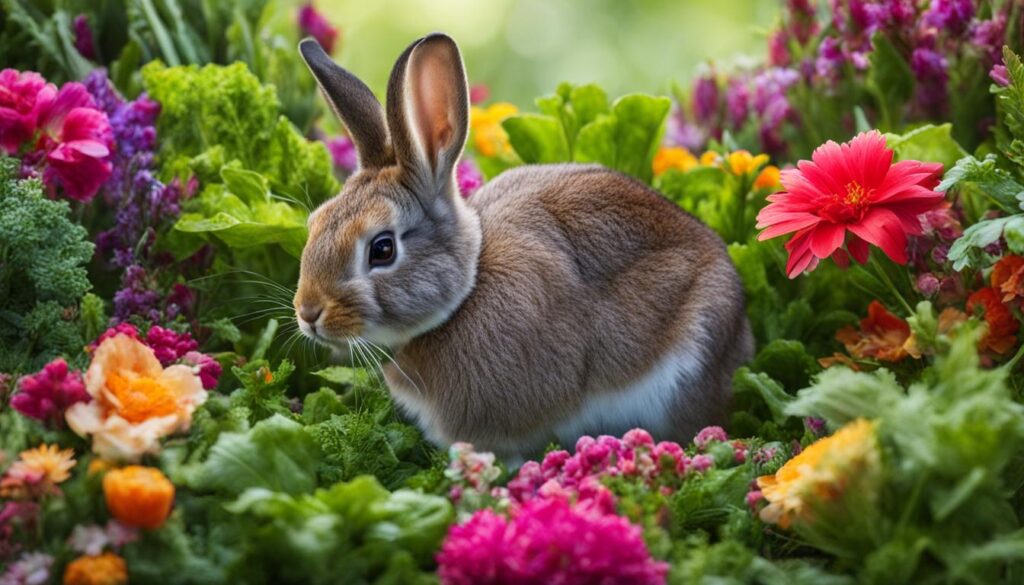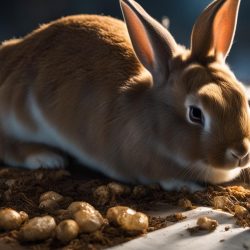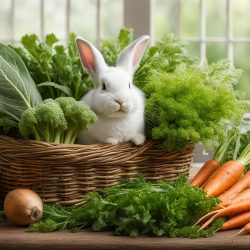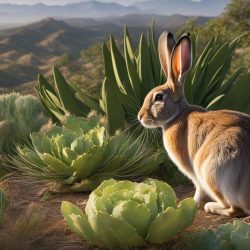Wild rabbits are fascinating creatures known for their adorable appearance and herbivorous diet. Have you ever wondered what these cute little creatures munch on in the wild? In this article, we will delve into the details of their natural diet, feeding habits, and dietary preferences. Understanding what wild rabbits eat can help us provide them with a suitable diet, whether they are in the wild or in captivity.
Key Takeaways
- Wild rabbits primarily maintain a plant-based diet consisting of various plants, grasses, and weeds.
- They have specific grazing habits and dietary preferences based on their lifestyle in the wild.
- Understanding their natural diet can aid in providing them with a balanced and appropriate diet in captivity.
- Their diet includes green plants, tree bark, twigs, leaves, flowers, and occasionally fruits and vegetables.
- Water is crucial for their hydration and overall health.
Understanding Wild Rabbit’s Lifestyle And Eating Habits
Wild rabbits have a unique lifestyle and specific eating habits that contribute to their survival in the wild. Their diet primarily consists of a variety of plants, grasses, and weeds, making them herbivores. Understanding their eating habits and grazing behavior provides valuable insights into their dietary needs.
Rabbits exhibit a nocturnal foraging behavior, meaning they are most active during the night. This behavior allows them to avoid predators and take advantage of the cooler temperatures that are beneficial for their survival. They graze heavily within the first half-hour of foraging, consuming a substantial amount of vegetation. After this initial feeding frenzy, they become more selective in their food choices.
Grazing Behavior
Rabbits are picky eaters and prefer fresh foliage over stems or dried plants. They have a keen sense of smell, enabling them to detect the quality and freshness of the vegetation they consume. This selective feeding behavior ensures that they obtain the most nutritious and palatable elements from their environment while avoiding potentially harmful or less desirable plant parts.
| Characteristic | Description |
|---|---|
| Picky Eating | Rabbits prefer fresh foliage over stems or dried plants. |
| Heavy Grazing | They consume a substantial amount of vegetation within the first half-hour of foraging. |
| Selective Feeding | Rabbits choose the most nutritious and palatable elements from their environment. |
Nocturnal Foraging
Rabbits are primarily nocturnal, which means they are most active during the night. This behavior helps them avoid predators and take advantage of cooler temperatures for optimal foraging. By feeding during the night, they can maximize their food intake while reducing the risk of being detected by predators.
| Characteristic | Description |
|---|---|
| Nocturnal Foraging | Rabbits are most active and feed during the night. |
| Predator Avoidance | Feeding at night helps them minimize the risk of being detected by predators. |
Understanding the wild rabbit’s lifestyle and eating habits is essential for providing suitable diets and maintaining their well-being in captivity. By replicating their natural feeding patterns and preferences, we can ensure they receive the necessary nutrients for a healthy life.
Life in Captivity for Wild Rabbits
When it comes to caring for wild rabbits in captivity, their diet plays a crucial role in their overall health and well-being. Providing a diet similar to their natural habitat is essential for their nutritional needs. Here are some key considerations for feeding pet rabbits:
Hay for Rabbits
Hay is a staple part of a captive rabbit’s diet. It provides essential fiber and aids in maintaining proper digestion. Choose high-quality hay, such as Timothy or orchard grass, and offer it freely to your rabbits. The hay should be fresh, dry, and free from dust or mold.
Leafy Greens
In addition to hay, incorporate a variety of leafy greens into your rabbit’s diet. Offer a range of options such as romaine lettuce, kale, cilantro, and parsley. These greens provide additional nutrients and hydration for your rabbit.
Pellets
Pellets can be included in your rabbit’s diet as a nutritional supplement, but they should not be the primary source of food. Choose high-quality pellets without added sugars or artificial preservatives. Offer them in moderation to prevent overconsumption.
Water Requirements
Providing access to clean and fresh water is essential for your captive rabbits. Ensure they have a constant supply of water in a clean and easily accessible container. Regularly check the water level and refill as needed.
In conclusion, a well-balanced diet consisting of hay, leafy greens, pellets, and water is essential for the health and happiness of captive wild rabbits. By mimicking their natural habitat, you can provide them with the nutrition they need to thrive in captivity.
Baby rabbits in the wild
When it comes to baby wild rabbits, also known as kittens, their diet and care differ from that of adult rabbits. For the first four weeks of their lives, baby rabbits rely solely on their mother’s milk for nourishment. The mother nurses them twice a day, providing essential nutrients for their growth and development.
After the nursing period, baby rabbits gradually begin to eat solid food on their own. They start nibbling on grasses and other plant materials, following their mother’s example. This transition to solid food is a critical stage in their development as they learn to forage and adapt to their natural environment.
It is important to note that baby rabbits should be left undisturbed in the wild unless they are physically injured or in immediate danger. The mother rabbit knows the best location to care for her young, and interfering with this natural process can cause more harm than good.
| Age | Feeding Behavior |
|---|---|
| Birth to 4 weeks | Nursing on mother’s milk |
| 4 weeks and older | Transitioning to solid food |
Understanding the nursing period and baby rabbit diet is essential for ensuring their well-being and allowing them to develop naturally in the wild. By leaving them undisturbed and respecting their natural feeding habits, we can contribute to their survival and growth as vital members of our ecosystems.
Spotting the Wild Rabbit Population and Habitat Distribution
Wild rabbits are abundant in various ecosystems around the world, with more than half of the global rabbit population found in North America. There are fifteen different species of rabbits and hares that inhabit diverse habitats such as grasslands, forests, deserts, mountains, and wetlands. These herbivorous animals have an adaptable nature and can be seen in both natural and human-altered environments.
Rabbit Species
North America is home to a wide range of rabbit species, each with its unique characteristics and habitat preferences. Some common rabbit species found in North America include the Eastern Cottontail, Desert Cottontail, Snowshoe Hare, and Black-tailed Jackrabbit. While they may share similar dietary habits, their appearances and behaviors may differ based on their specific species.
Habitat Distribution
Wild rabbits can be found across various geographical regions within North America. They are known to populate areas such as parks, university campuses, roadsides, golf courses, and even suburban neighborhoods. Their ability to adapt to human environments has led to their widespread distribution and coexistence with urban and rural landscapes.
| Rabbit Species | Main Habitat | Geographical Distribution |
|---|---|---|
| Eastern Cottontail | Woodlands, fields, suburban areas | Eastern and Central regions of North America |
| Desert Cottontail | Deserts, arid regions | Southwestern United States and Mexico |
| Snowshoe Hare | Boreal forests, coniferous forests | Northern regions of North America |
| Black-tailed Jackrabbit | Grasslands, desert scrublands | Western regions of North America |
As herbivores, wild rabbits play an essential ecological role in their natural habitats by helping to manage plant populations and dispersing seeds through their droppings. Understanding their population and distribution can contribute to better conservation efforts and coexistence with these fascinating creatures.
What Do Wild Rabbits Eat?
Wild rabbits have a diverse and plant-based diet, consuming a variety of grasses, weeds, clover, bark, twigs, leaves, and flowers. They are opportunistic eaters, foraging on whatever plants are available in their habitat. Their preference lies in fresh and delicate foliage, often climbing tree trunks to reach leaves or dew-laden vegetation.
Here is a breakdown of the different components in a wild rabbit’s diet:
- Grasses: Wild rabbits graze on various types of grasses, including both dry and green grasses.
- Weeds: They also consume a variety of weeds, which provide them with additional nutrients.
- Clover: Clover is a preferred food source for wild rabbits, rich in vitamins and minerals.
- Bark and Twigs: In the winter season when green plants are scarce, rabbits modify their diet to include more woody plants. They feed on tree bark, twigs, and even pine needles.
- Leaves and Flowers: Wild rabbits include leaves and flowers as part of their diet. They often consume wildflowers they come across while grazing on grass.
It’s important to note that while wild rabbits may consume certain fruits and vegetables in the wild, their diet primarily consists of plants and foliage. Providing a balanced and suitable diet is crucial for the health and well-being of wild rabbits in captivity or those being cared for as pets.
Table: Wild Rabbit Diet
| Food | Description |
|---|---|
| Grasses | Includes various types of grasses, both dry and green. |
| Weeds | Includes a variety of weeds that provide additional nutrients. |
| Clover | A preferred food source, rich in vitamins and minerals. |
| Bark and Twigs | Consumed in winter when green plants are scarce. Includes tree bark, twigs, and pine needles. |
| Leaves and Flowers | Includes a variety of leaves and wildflowers found while grazing on grass. |
Woody Plants in the Winter Diet of Wild Rabbits
During the winter season, when green plants are scarce, wild rabbits adapt their diet to include more woody plants. They turn to twigs, tree bark, and even pine needles to meet their nutritional needs. These woody plants provide rabbits with essential fiber and the necessary chewing action to maintain their teeth.
Woody plants make up a significant portion of a wild rabbit’s winter diet. They are a valuable source of nutrients, allowing rabbits to survive when other food sources are limited. Rabbits have a remarkable ability to digest and extract nutrition from these tough and fibrous materials, ensuring their survival during the colder months.
The Importance of Woody Plants in Winter
Woody plants serve as an important food source for wild rabbits in winter due to their availability and the nutritional benefits they provide. Here are some key points to understand:
- Twigs: Rabbits consume twigs from various tree species such as birch, willow, and apple. They nibble on the soft, young twigs that are easily accessible and contain more nutrients.
- Tree Bark: Tree bark is another essential food source for rabbits during winter. They chew on the outer bark layer, which provides them with vital nutrients and roughage.
- Pine Needles: Some rabbit species, such as the snowshoe hare, incorporate pine needles into their winter diet. Pine needles offer additional nutrients and help rabbits maintain their digestive health.
Rabbits have a remarkable ability to extract the necessary nutrients from woody plants, even during the winter when green vegetation is scarce. Their specialized digestive system, combined with their selective feeding behavior, allows them to efficiently utilize the available resources to sustain themselves in cold climates.
| Woody Plants in the Winter Diet of Wild Rabbits | Key Points |
|---|---|
| Twigs | Soft, young twigs from various tree species |
| Tree Bark | Provides vital nutrients and roughage |
| Pine Needles | Additional nutrients and digestive health benefits |
Through their adaptation to include woody plants in their winter diet, wild rabbits demonstrate their resourcefulness and ability to survive in challenging environments. The consumption of twigs, tree bark, and pine needles ensures that rabbits can meet their nutritional requirements and maintain their overall well-being during the colder months.
Flowers
Flowers are a dietary supplement in the wild rabbit’s diet. While grazing on grass, wild rabbits often consume wildflowers they come across. Flowers provide rabbits with a source of pleasant taste and fragrance. However, it is important to note that not all flowers are suitable for rabbit consumption. Some flowers may be toxic or can irritate their stomachs, resulting in negative effects. In such cases, rabbits may stop eating them to avoid any discomfort.
Wild rabbits have a natural instinct to select a diverse range of plants and plant parts for their diet, including flowers. While their primary source of nutrition comes from plants and grasses, flowers add variety to their diet and offer different flavors and scents. However, it is essential to ensure that the flowers they consume are safe and non-toxic.
| Flowers Consumed by Wild Rabbits | Notes |
|---|---|
| Dandelions | A common flower found in meadows and lawns. Rabbits can safely consume all parts of the dandelion plant. |
| Chamomile | A flowering herb that rabbits find appealing. It is safe for them to eat, and the flowers can be dried and provided as a treat. |
| Marigold | Rabbits can eat the petals of marigold flowers. However, excessive consumption may lead to an upset stomach. |
It is important to research and identify safe flowers for rabbits before offering them as a dietary supplement. Providing a varied diet that includes flowers can contribute to the overall well-being and enrichment of captive wild rabbits.
Vegetables and Fruit
Contrary to popular belief, wild rabbits do not primarily eat root vegetables such as carrots. Their diet consists more of legumes and leafy greens. While they may consume certain fruits and vegetables in the wild, their preference lies in consuming fresh plants and foliage. It is important to provide a balanced diet and avoid excessive amounts of high-sugar fruits or vegetables that lack essential nutrients.
When it comes to vegetables, wild rabbits have a preference for leafy greens such as kale, spinach, and romaine lettuce. These greens are rich in vitamins and minerals, providing essential nutrients for their overall health. Additionally, legumes like peas and beans can be included in their diet as a good source of protein and fiber.
As for fruits, wild rabbits may occasionally consume fruits that are low in sugar, such as berries and apples. These fruits can provide some variety and additional nutrients to their diet. However, it is important to note that fruits should only be given in moderation, as excessive sugar intake can lead to health issues such as obesity and dental problems.
| Vegetables | Fruits |
|---|---|
| Kale | Berries (in moderation) |
| Spinach | Apples (in moderation) |
| Romaine lettuce | – |
| Peas | – |
| Beans | – |
Providing a balanced diet that mimics their natural habitat is crucial for the health and well-being of wild rabbits in captivity. It is recommended to consult with a veterinarian or a wildlife expert to ensure that their dietary needs are met and to receive guidance on suitable food options.
Water Requirements for Wild Rabbits
Water is essential for the hydration and overall health of wild rabbits. They rely on various water sources in their habitat to meet their water intake needs. These sources include natural bodies of water such as streams, ponds, and lakes, as well as rainfall. Wild rabbits have adapted to obtain water from these sources and can efficiently extract the moisture they need to support their bodily functions.
In captivity, it is important to provide captive rabbits with access to clean and fresh water at all times. A clean water dispenser or bowl should be available in their enclosure, and it should be regularly monitored and refilled to ensure an adequate water supply. Providing fresh water is crucial for maintaining proper hydration and overall health in captive wild rabbits.
Water Sources for Wild Rabbits:
Wild rabbits obtain water from various sources in their natural habitat. Here are some common water sources for wild rabbits:
- Natural bodies of water such as streams, ponds, and lakes
- Rainfall and dew on vegetation
- Moisture-rich plants and green vegetation
These natural water sources play a crucial role in meeting the hydration needs of wild rabbits. They have adapted to extract moisture from these sources to support their bodily functions and maintain overall health.
| Water Requirements for Wild Rabbits | Hydration |
|---|---|
| Wild rabbits require an adequate supply of water to support their digestion and overall health. | Water plays a vital role in maintaining proper hydration and bodily functions. |
| They obtain water from natural bodies of water, rainfall, and moisture-rich plants in their habitat. | Wild rabbits have adapted to extract moisture from these sources. |
| In captivity, it is important to provide access to clean and fresh water at all times. | A clean water dispenser or bowl should be regularly monitored and refilled. |
Life Cycle and Survival
Wild rabbits have a relatively short lifespan, with certain species living less than one year due to various factors. Disease, starvation, and predation pose significant challenges to their survival. These animals reach sexual maturity at a young age, with some species being able to reproduce as early as three months old. Their rapid reproduction allows them to compensate for the high mortality rate and maintain their population.
During the reproduction process, rabbits engage in mating rituals that involve chasing, leaping, and sometimes fighting. Females have multiple litters per year, with each litter consisting of 3 to 8 kittens. The gestation period ranges from 28 to 35 days, depending on the species. After birth, the mother will nurse her offspring twice a day, providing them with essential nutrients for their growth.
Predators and Survival Challenges
Wild rabbits face a wide range of predators that threaten their survival. These include birds of prey, such as hawks and owls, as well as ground-dwelling predators like foxes, coyotes, and snakes. Survival challenges also encompass competition for food and shelter within their habitat. Additionally, rabbits are susceptible to various diseases and parasites, which can further impact their longevity.
Adaptations for Survival
Despite the numerous challenges they face, wild rabbits have evolved several adaptations that contribute to their survival. Their keen senses, including excellent hearing and a wide field of vision, help them detect potential threats in their surroundings. They are also prodigious diggers, creating complex burrow systems that provide them with shelter and protection from predators. Furthermore, their ability to reproduce quickly helps ensure the survival of their species even in harsh conditions.
| Species | Average Lifespan | Reproduction | Predators |
|---|---|---|---|
| Eastern Cottontail | 1-3 years | Multiple litters per year | Foxes, coyotes, snakes |
| European Rabbit | 1-5 years | Multiple litters per year | Birds of prey, foxes, stoats |
| Black-tailed Jackrabbit | 1-7 years | Multiple litters per year | Coyotes, eagles, bobcats |
Conclusion
In conclusion, understanding the diet and eating habits of wild rabbits is crucial for providing appropriate nutrition and ensuring their well-being, whether in the wild or in captivity. Wild rabbits primarily rely on a plant-based diet, grazing on a variety of plants, grasses, and weeds. They are picky eaters and prefer fresh foliage over dry or woody plants.
It is important to note that the diet of wild rabbits varies based on their habitat and the availability of food sources. In the winter, they shift to consuming more woody plants such as twigs, tree bark, and pine needles. They also include flowers as part of their diet, providing them with a source of taste and fragrance.
Contrary to popular belief, wild rabbits do not primarily consume root vegetables like carrots. While they may occasionally eat certain fruits and vegetables in the wild, their preference lies in consuming legumes and leafy greens. Water is also vital for their hydration and digestion. Wild rabbits rely on available water sources in their environment and need access to clean and fresh water.
By understanding the natural diet and eating habits of wild rabbits, we can ensure that captive rabbits receive a balanced and suitable diet, and appreciate the vital role these cute herbivores play in our ecosystems.
FAQ
What do wild rabbits eat?
Wild rabbits primarily maintain a plant-based diet and graze on a variety of plants, grasses, and weeds. They also consume tree bark, twigs, and pine needles in the winter season when green plants are scarce.
What should I feed a wild rabbit in captivity?
In captivity, wild rabbits should be fed a diet similar to their natural habitat. This includes all sorts of hay (except alfalfa), various leafy greens, a few pellets for added nutrition, and plenty of water. Avoid feeding foods that can cause gas or bloat, and provide enough space for exercise.
How do baby wild rabbits eat?
Baby wild rabbits, called kittens, are fed rabbit breast milk by their mothers twice a day for the first four weeks. After this period, they start eating solid food themselves and gradually transition to an adult diet.
Where can I spot wild rabbits?
Wild rabbits can be found in various ecosystems such as grasslands, forests, deserts, mountains, and wetlands. They are also adaptable to human environments and can be seen in parks, university campuses, roadsides, and golf courses.
What types of plants do wild rabbits eat?
Wild rabbits eat a diverse range of plants, including grasses, weeds, clover, bark, twigs, leaves, and flowers. Their diet depends on the availability of these plant sources in their habitat.
Do wild rabbits eat tree bark and twigs?
Yes, wild rabbits modify their diet in the winter season to include more woody plants. They feed on twigs, tree bark, and even pine needles. These foods provide them with nutrition, fiber, and the necessary chewing action to maintain their teeth.
Do wild rabbits eat flowers?
Yes, wild rabbits include flowers as part of their diet. They often consume wildflowers they come across while grazing on grass. Flowers can provide rabbits with a source of pleasant taste and fragrance.
Do wild rabbits eat vegetables and fruit?
Wild rabbits consume certain fruits and vegetables in the wild, but their preference lies in fresh plants and foliage. They primarily eat legumes and leafy greens, rather than root vegetables like carrots. It is important to provide a balanced diet and avoid excessive amounts of high-sugar fruits or vegetables that lack essential nutrients.
How much water do wild rabbits need?
Water is crucial for the nutrition and hydration of wild rabbits. They require an adequate supply of water to support their digestion and overall health. In the wild, they rely on available water sources such as streams, ponds, or rainfall. In captivity, it is essential to provide access to clean and fresh water for rabbits.
How long do wild rabbits live?
Wild rabbits have a short lifespan, with the average longevity of certain species being less than one year. They face various survival challenges such as disease, starvation, and predation.
What is the importance of understanding wild rabbit eating habits?
Understanding what wild rabbits eat and their natural dietary preferences is important for providing suitable diets for captive rabbits and appreciating their ecological role as herbivores. It helps ensure their health and well-being in captivity.





